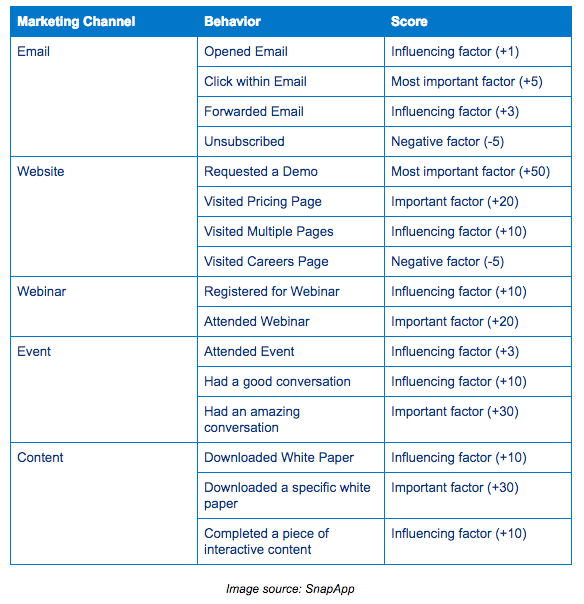
Social Factor
Finding Your Future at SF: Where Growth Meets Opportunity

You know you should pursue leads with your digital and social media marketing, but what are the good or qualified leads?

“Wait, what are you talking about!? You don’t understand. We don’t have a lot of leads. We’re always excited to chase the ones that enter our funnel, no matter what! One of them will pay off and buy something, we’re positive. They’re all good leads as far as we’re concerned, and we’ll continue to give each of them the highest amount of attention we can. Plus, we don’t want to think of our social media followers or the subscribers in our database as “leads.” They’re real people.”
Exactly. They’re real people. And people are complex and should never be grouped as one group, with everyone receiving the same message or offer because personalization matters. 79% of consumers say they are only likely to engage with an offer if it has been personalized to reflect previous interactions the consumer has had with the brand.
Also, your team’s time and the company’s bottom line are precious. Why waste time and not pursue and close leads as efficiently and effectively as possible?
This brings us back to the question: How do you determine a good or qualified lead for your business?
We like using lead scoring, personally. What is that, you ask? It’s a way to take your people, divide them into different types (called segments), and assign different scores that better help your sales team or marketing automation tool (like if you’re using Hubspot, Marketo, Infusionsoft, Pardot, etc.) trigger personalize messaging and offers based off of your people’s behavior on your website or social media.
Pretty cool, huh? Talk about closing sales as efficiently as possible.
Let’s back up a bit and unpack.
When you segment your people, you divide them into different groups and personalize your outreach to fit each of those groups. For instance, your segment groups could look like:
— People who have taken the time to engage with your brand and shown buyer’s intent and need more education or persuasion.
— People who show immediate buyer’s intent and need an urgent offer or directions to your “send a quote landing page” or e-commerce point of sale.
— People who will never buy something from you but will say really nice things about you, influencing others who could buy for you.
— Subscribers who just want to stay in touch because someday they might need you
— Competitors who are watching your brand.
— Detractors who aren’t happy with your brand.
Think of when you’re getting to know new people. You might know a little bit about them, but many times, your knowledge is a blank slate. Will that new person you met be a golfing buddy, a brunch friend, or someone who could serve as your emergency point of contact? You get gut feelings, thinking you might know which group a person could belong to, but you’re not certain. So, how do you help your people land in the right group? You make judgments based on their behaviors.
Lead scoring works exactly the same way, but with numbers assigned based on user behaviors and actions taken or not taken on your website and social media.
The formal definition of lead scoring (in case your boss asks) is a way to rank prospects against a scale that underscores the perceived value each possible lead represents to your business. Depending on the resulting value assigned, you’ll better understand how to or if you should even bother to engage or not engage with a lead.
Some lead scoring systems give you actual numbers (say, scoring ranging from -50 to +100), and others employ flames or similar graphics so you know which leads are cold, warm, and hot, hot, hot. Either way, the lead scoring system helps your market and sales teams stop throwing all leads at the wall and hoping something sticks.
The most accurate lead-scoring models contain both explicit and implicit information.
— Explicit scores are based on data provided by or about the prospect, for example, how big their company is, what they do in their industry, or where they are located.
— Implicit scores are discovered by monitoring prospect behavior; examples of these include tracking what parts of your website they’re visiting, whether or not they’ve taken advantage of any of your lead magnets like a free whitepaper download or e-book, and how often and on what topics they choose to open certain e-mail and click on link.
— You can also track how engaged your lead is by assigning a social score – it predicts lead relevancy based on analyzing a person’s presence and activities on social media.
A lead score model might look like this:

No matter how you score, the big takeaway is that you understand you should be scoring leads because it allows your business to personalize that new or ongoing prospect’s experience based on his or her buying stage and interest level.
Remember, today’s potential customers are smart. Lead scoring improves the quality of leads your team is working with.
— Increase in revenue
— Increase efficiency and effectiveness in sales: Lead scoring sharpens an understanding of buyer’s intent and focuses attention on leads that your business stakes out as most valuable, ensuring that leads that are unqualified or have low perceived value are not given sales/staff time following up.
— Increase effectiveness in marketing: A lead scoring model quantifies for your marketing team what types of leads or lead qualities are most valuable to your business, which in turn helps your marketing team more effectively target its inbound and outbound campaigns, deliver more high-quality leads to sales, or stop wasting money on certain segment types for your advertising or digital media dollars.
— Increased alignment in marketing and sales: Lead scoring helps break down silos and positions the relationship between marketing and sales as playing on the same team, which can only lead to more collaboration when designing and implementing your operations.
According to a 2015 study by Spear Marketing, 68% of B2B marketers use both behavioral and demographic scoring. It’s a promising statistic, but as the study further states, many marketers are not getting the most out of their lead-scoring systems.
Here are six further tips to boost your lead scoring model to the next level and improve sales productivity:
1. Don’t Only Score Email Opens
You are talking to your people in many ways, we imagine? (If you aren’t sure, contact Social Factor for an audit of your digital marketing, and we can help you better understand what your marketing is doing for your business). You are engaging on social media, through online advertising, through influencers, and through email.
With that in mind, email is just one touch. And while an email open indicates some measure of engagement with your brand and company, it’s not the only engagement. However, only using or over-weighting email opens as your lead score leader can quickly lead to inflated lead scores.
Instead, you might measure page views generated from the email or downloads from a lead magnet contained in the email. We recommend you develop a lead scoring model that uses a combination of opens, clicks, and conversions.
2. Assign a higher value to certain actions and web pages
Building on the premise from our first tip, not every action a prospect takes should be equal when it comes to lead scoring. Audit your website analytics to understand what web pages might be of high value to a potential client, such as a Contact Us form, evergreen resource pages, or your e-commerce with a shopping cart section.
You can also rank your free downloads or subscription series like podcasts or weekly webinars. Shake out what’s valuable and assign higher point values to these activities to gain a better “at a glance” look at where your customer or prospect is headed on his or her journey.
Here are a few examples of how you might weigh out the potential prospect touchpoints:
— Download a whitepaper – Add 5 points
— Watch a product demo video – Add 4 points
— Prospect job role not a good match for buyer persona – Deduct 10 points
— Fill out an opt-in form – Add 8 points
— Unsubscribe from a list – Deduct 8 points
Pro tip? As you should be routinely reviewing, clarifying, and updating your segment groups, you should also routinely review and clarify value for your downloads, web pages, and other actions you’ve assigned certain values to ensure your funnel stays streamlined and smooth without bias or vanity bloat.
3. Set your lead-scoring thresholds
According to the same Spear Marketing study, 46% of B2B marketers do not have lead-scoring thresholds that automatically alert or route leads to sales. Here’s where you should take advantage of your marketing automation tool (and if you’re not set up with one, contact Social Factor for a free consultation to see if automation can help your business.)
Automation rules are just like they sound: rules in place that transform leads into salable opportunities. In most cases, this means that the prospect is considered qualified, and rather than having to have someone on your team remember to assign them a salesperson or shift to the next part of the lifecycle manually, the lead information automational transforms from a lead to a marketing qualified lead (MQL), or they automatically route into the next level of your funnel where they’ll get a more high-touch approach since they’ve reached a SQL (sales qualified lead) indicator.
It’s okay to have different thresholds in place, as well, for low, medium, and high indicators for a couple of reasons:
— You run an e-commerce business. Your blog subscriber, who has read your blog for three months, wants to try a sample of your new product. By ordering a sample, they move from a subscriber to an MQL. Which moves them from a low indicator of sales to a high one.
— You run a B2B business. Your email subscriber receives an email about a safety program. They don’t click on the CTA that would have them buy safety training, but instead, they click on the “learn more about the safety program” link in the email. This action moves from a low score into a medium score, where the lead is still understood to need more information and persuasion before sending a direct sales offer.
4. Use separate lead scoring models
One of the businesses I previously worked with had a wedding planning vertical, a corporate conference planning vertical, and a trade show planning vertical. All the verticals serve the larger market for special events and hospitality meeting planning, but I helped them set up three separate lead scoring models for each vertical.
Why did I do this? Having separate models allows the business to target the scores allocated to each prospect more effectively and efficiently and ensure they correctly reflect a prospect’s wants and desires.
For example, if a prospect interested in wedding planning information is being scored using a blanket scoring model that also takes the conference and trade show planning information into account, it may not reflect the high interest and level for the right products specific to the wedding planner vertical. Which means the lead may not get the attention from the right salesperson that they deserve.
5. Have clearly outlined sales follow-up process and/or templates that include lead score context
Having internal processes that have outlined clear milestones and one clear end-game makes for a powerful organization.
What does this look like for B2B:
This is never truer than when considering the relay race baton handoff of the lead qualified by marketing to the sales team. One of the most commonly missed pieces is how someone from the sales couldn’t follow up well because they didn’t have the right context for the prospect he or she engaged with. Make certain you send the SQL with notes that give a better picture.
Simply sending leads to your sales team’s pipeline without context or prioritization misses out on an opportunity with lead scoring. Ventilate your silos. Have your marketing and sales teams be part of the process to map the customer’s journey from the top of the funnel through the signing of the contract (and ongoing engagement after they’ve become a buyer!).
What does this look like for e-commerce or B2C:
So much of B2C or e-commerce sales should never be felt by the customer. Having a conversion path is critical to success for ease of sale. This is where marketing and sales automation PLUS your e-commerce website can be incredibly powerful.
For instance, your e-commerce site has a new product promotion. You segment your list to send out promotions to people who are most likely to buy and will likely get increased sales. But if you also set up a lead scoring model with characteristics of a likely buyer. Then, create a workflow using automation that that shows how a user (whether you’ve previously identified them or not) could trigger an offer to take an advantage of the new promotion by leading them directly to point of sale, revenues should rise without you having to any other work than setting it up.
6. Use negative scoring and reduction model
50% of companies can benefit from putting a scoring reduction model in place. Why? Because prospects could use your lead magnets for many different reasons. A prospect might over-inflate her score because she’s doing research for a college project on your site’s subject matter expertise. Another is a current client who continues to take advantage of your thought leadership lead magnets like a safety checklist but doesn’t want to buy your safety program because they already have one. You might know that already, but unless you structure your lead model correctly, that client record isn’t being scored according to the right model, leading your sales team or automation tool to treat them differently.
Using reduction model tactics can reduce bias in your scoring system and keep scores honest, so to speak. Similarly, negative scoring can be used to dock points from leads who have gone inactive or who visit your specific resources, indicating a preference for learning only rather than learning AND purchasing.
Pro tip? Be certain to include measurements from these downward or stalled scores in your analytics dashboard, along with upward lead score growth. There’s an important story to be told from a lead that changes direction or doesn’t grow as fast as anticipated.
What are some of your favorite lead-scoring best practices? Share ’em below

Finding Your Future at SF: Where Growth Meets Opportunity

Transform your Digital Strategy by Using Tech and SaaS for Optimal Resource Utilization

Building Brand Loyalty Through Authentic Human Connection

Sail Through 2025 Social Media Budget Planning with Ease

How Brands Can Navigate Pre-Election Chaos on Social Media

Threads: Is It Worth It Yet?

Jack “Of All Trades” Dorsey Is No Longer on the Bluesky Board

Celebrating Diversity at Social Factor

Coachella 2024: What It Takes to Livestream the Festival on YouTube

How Fort Worth’s Social Factor Is Rocking ‘Human Connection’